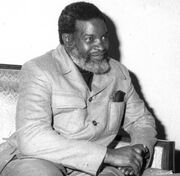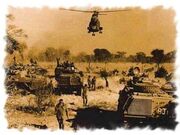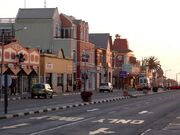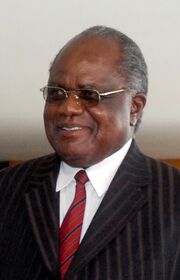One Namibia, One Nation | |||||
| Anthem | "Alert Namibia" | ||||
| Capital (and largest city) |
Windhoek | ||||
| Other cities | Omuthiya, Tsumeb Eenhana, Grootfontein, Ondangwa, Outapi, Lüderitz | ||||
| Language official |
English | ||||
| others | Ovambo, Nama, Afrikaans, German | ||||
| Demonym | Namibian | ||||
| Government | Semi-presidential republic with a dominant party | ||||
| President | Nahas Angula | ||||
| Area | 262,866 km² | ||||
| Population | 903,020 | ||||
| Independence | April 19, 1984 | ||||
| Currency | Namibian Kalahar | ||||
Namibia is a country in southern Africa. It shares land borders with the Republic of Angola to the north, Botswana to the east, South West Africa to the west, and Volkstaat to the south. It formally declared independence from South Africa on 19 April 1984, following a long struggle and the collapse of the country in the aftermath of World War III. Its capital is Windhoek. Namibia is a member of the League of Nations.
History[]
Pre-Doomsday[]
The dry lands of Namibia were inhabited since early times by Bushmen, Damara and Namaqua, and since about the 14th century AD by immigrating Bantu who came with the Bantu expansion. It became a German Imperial protectorate in 1884 and remained a German colony until the end of World War I. In 1920, the League of Nations mandated the country to South Africa, which imposed its laws and, from 1948, its apartheid policy.
Uprisings and demands by African leaders led the UN to assert direct responsibility over the territory. It recognized the South West Africa People’s Organization (SWAPO) as the official representative of the Namibian people in 1973. Namibia, however, remained under South African administration during this time, a province in all but name with a large and visible military presence. In August 1983, South Africa seated a Multi-Party Conference, composed of members of a range of moderate parties but pointedly excluding SWAPO, to begin to transition the territory toward some kind of self-government. The global emergency that began the next month halted these plans.
Independence[]

Sam Nujoma
Although no nuclear weapons were dropped on South or South West Africa, the chaotic postwar situation was tremendously destabilizing. As civil unrest grew in the provinces of Natal and Transvaal, South Africa had to divert troops from the northern border, reducing the pressure on Namibian insurgents both in the Ovamboland bantustan and across the border in Angola. Over the course of 1984 and 5, the depleted South African Defense Forces would begin to withdraw steadily toward the capital.
PLAN, the military wing of SWAPO, crossed the border from Angola in early 1984, proclaiming Namibia's independence on 19 April. As South Africa careened toward collapse, President Sam Nujoma came into the country in 1985 and established a temporary capital at Omuthiya. By the end of the year, the military front had moved to just north of Windhoek. South Africa had lost the northern third of the country.
Nujoma, accustomed to decades of guerrilla war, felt vulnerable outside Angola, where PLAN had enjoyed the protection of FAPLA, Cuban, and Soviet forces. So he and the military leaders of PLAN did not press the offensive immediately. Instead he set about organizing the new government. With war ongoing, one-party rule seemed the only option. Elections were held for an new parliament - but only among loyal SWAPO members. The priority was strengthening the new regime's control of the countryside to prepare for the next battle against South Africa.
The opportunity came in 1987. During that year, South African rule collapsed all over the country. Forced out of Pretoria, the govenrment fled to Cape Town, and even there had to compromise with the Coloured populatiom in the form of the Volkskongres party and the leaders of a rural insurgency. The government called all SADF troops to the Cape to defend the new capital. Some forces in South West Africa chose to stay, not trusting the new biracial government. But the order deflated the resistance of those still in Windhoek. Civilians began to evacuate in large numbers toward Walvis Bay; many would keep moving until they reached Cape Province. After a few more days of bloody fighting, South African forces abandoned the capital to Namibia.
SWAPO was officially committed to a multiracial Namibia, and the party could boast of White members, especially among the liberal intelligentsia - and some were now participating in Nujoma's government. But the days after the capture of Windhoek saw a good deal of persecution against those suspected of supporting apartheid. White-owned farms and businesses were confiscated, and the dispossessed joined the Windhoek migrants in Walvis Bay.
The Southwest War[]

Namibian troops marching to Walvis Bay.
In 1990, Nujoma felt ready to complete the liberation of the country and ordered a final attack on Walvis Bay. By now, South Africa no longer existed. The Cape Town government had fallen, replaced with the Republic of the Cape. The loyalists holed up in Walvis Bay had accordingly declared themselves to be a new Republic of South West Africa - and they were prepared to defend it.
The initial campaign to seize the city was rebuffed, and Namibia lacked the resources to wage a protracted campaign. Instead the Southwest War turned into an extended period of brutal guerrilla fighting. South West African cadres made their way behind Namibian lines to employ tactics that SWAPO had once used against South Africa: land mines, sabotage, and hit-and-run rocket attacks. This period of low-intensity violence was punctuated by explosive conflicts in 1993 and 4. Large stretches of both Walvis Bay and Windhoek were destroyed. The Namibian government had to return to Omuthiya as the central part of the country became a war zone.
By 1995, over 8,000 people were dead and more than 20,000 displaced throughout Namibia. Both sides had utterly expended their capacity to carry on the fight, and Nujoma saw that he could not both crush SWA and organize a stable government for his country. The two sides signed a peace treaty and agreed to coexist peacefully. The South West Africans would be secure in the land around Walvis Bay, while the remainder of the land would go to the SWAPO state. The agreement provided for a resumption of trade between Walvis Bay and Windhoek, something necessary for both countries. And SWA agreed to abolish apartheid, though various racial laws remained in force.
Reconstruction[]

Omuthiya during its period as the capital.
After the devastating Southwest War, Nujoma focused his efforts in rebuilding Namibia. The capital had to remain in Omuthiya for several years while Windhoek dug itself out of the rubble. Many outlying areas, especially the Caprivi Strip and the Afrikaans-speaking south, remained beyond the government's reach.
Official one-party rule persisted for the rest of the decade. In 2001, SWAPO fulfilled its long-delayed promise and permitted Namibia to hold multiparty elections. The party had little to fear; it had won the country its independence and faced no serious competition.
The Sperrgebiet Crisis[]
By the late 90s, both South West Africa and Namibia were exploring the Sperrgebiet, a now-uninhabited diamond-mining area along the southwestern coast. The land belonged to Namibia under the terms of the treaty, so when the South West Africans refused to leave, it sparked a major crisis and a Second Southwest War in 2000. Nujoma and SWAPO believed that the opportunity had finally arrived to reunite and liberate all of Namibia.
Namibian forces were able to destroy or capture SWA mining operations in the disputed area. But once again, Walvis Bay proved too well defended. Rather than repeat the brutal campaign of 1990-95, Nujoma accepted a Botswanian offer of mediation. Most of the disputed territory went to Namibia, but SWA obtained a token strip of coastline, new guarantees of its independence, and mining rights in certain sectors of the Gebiet. The new treaty settled a number of outstanding issues between the two states and finally set the stage for normal relations between them.
After Nujoma[]
Nujoma announced that he would retire in 2005, and his hand-picked successor Hifikepunye Pohamba became the SWAPO presidential candidate. Pohamba was elected in a landslide victory, which critics denounced as a flawed election. Under Pohamba, Namibia sought to extend its influence within its de jure borders. The country secured the land route to the Sperrgebiet and began to redevelop the port of Lüderitz. Pohamba requested membership for Namibia in the League of Nations just before he was reelected in 2009.
Pohamba was narrowly defeated by his Prime Minister, Nahas Angula, in the 2013 general elections.
Government[]

Former Namibian President Hifikepunye Pohamba
The Government of Namibia consists of the executive, the legislative and the judiciary branches. The Cabinet is the executive organ of government, implementing the laws of the country. It consists of the President, the Prime Minister and his deputy, as well as the Ministers. The legislative organs of government are the National Council and the National Assembly. They make the laws of the country. The judiciary organs of government are the courts. The highest court of Namibia is the Supreme Court. There is also the High Court, and lower courts.
The Namibian government is partly centralised and partly regional. In the executive branch, Central government consists of ministries, offices and agencies, whereas regional government consists of Regional Councils, and constituencies within these. The legislation is centralised in the lower house (National Assembly), and regional in the upper house (National Council). The judiciary is centralised in the Supreme Court, whereas High Courts and lower courts are distributed all over the country.
Education[]
Education in Namibia is compulsory for ten years between the ages of six and 16. The Constitution directs the government to provide free primary education. However, families must pay fees for uniforms, books, hostels, and school improvements.
Military[]

APCs of the Namibian Military.
Namibia's principal military arm is the Namibia Defence Force, which was formed from the People's Liberation Army of Namibia (the military arm of SWAPO), and members of the South West African Territorial Force that switched sides after the breakup of South Africa. The main roles of the NDF are to "ensure the sovereignty and territorial integrity of the country against external aggression, both conventional and unconventional; prevent violation of Namibia’s territorial integrity; and provide assistance to civil authorities in guarding and protecting government buildings and key installations as provided in the Defence Act." However, the NDF's effectiveness is hampered by inadequate training and equipment.
Its Commander-in-Chief is President Nahas Angula.
Territory[]
Namibia controls most of the former South-West Africa. The Caprivi Strip remained outside its control in the early years after declaring independence, and by the time Namibia turned its attention there, it had organized an independent government for itself. Later it was annexed by Botswana.
The state's control remains shaky in the far south, a very dry area where most inhabitants speak Afrikaans and have ties to South Africa. Volkstaat has made some encroachments there.
Walvis Bay and the land around it constitute the Republic of South West Africa, an independent, White-dominated state. Since 2000 Namibia has largely given up on the idea of taking it over. The northern coastland is the desolate Skeleton Coast, for the most part uninhabited and abandoned.
Symbols[]

Flag of Namibia
For its flag, Namibia adopted the flag of SWAPO, the organization that won independence for the nation and which remains its ruling party. It is a blue, red, and green tricolor.
Many of Namibia's other national symbols, such as its motto and anthem, were also simply carried over from the party symbols of SWAPO.
Economy[]
Walvis Bay remains the main port serving Namibia, despite its being the seat of an independent republic. Namibia has the right to import and export through Walvis Bay without paying taxes. Angola, Botswana and the states of South Africa are also important trading partners.
Most of rural Namibia relies on subsistence farming. A majority of its people live below the international poverty line. Namibia still must import some of its food.
Mining provides a large part of Namibia's revenue. The country is a major source of gemstones like diamonds, and other mineral exports include lead, gold, tin, fluorspar, tungsten, manganese, marble, zinc, and copper.
Namibia and SWA had discussed plans to build themselves into a regional transport hub, but with Botswana gaining sea access through the Okavango, this plan has failed to materialize. A transportation corridor brings in trade from South Africa.
Sports[]
The principal sports in Namibia are association football, rugby union, golf and fishing. Boxing and athletics are also popular. Cricket is popular only among the Afrikaans and German populations, with the rest showing hardly any interest.
The Namibian national rugby union team regularly plays the other teams in the region.
International Relations[]
Namibia's most important and complex relationship is with South West Africa. The two states fought three or four wars in the past, depending on how one counts, and for this reason the relations are fraught with tension. The rights of Namibian citizens working in Walvis Bay are a perennial point of dispute. Other arguments rage over matters ranging from SWAPO's confiscation of White-owned businesses in the 90s, to the German genocide against the Herero a century earlier.
Namibia's liberal trade regime with SWA makes it a de facto part of the free-trade zone of the African Economic Community, which SWA joined in 2014. So far Namibia has been reluctant to join outright.
Namibia has embassies in the Republic of Angola, Botswana, and most of the states of South Africa.
See also[]
| ||||||||||||||||||||

